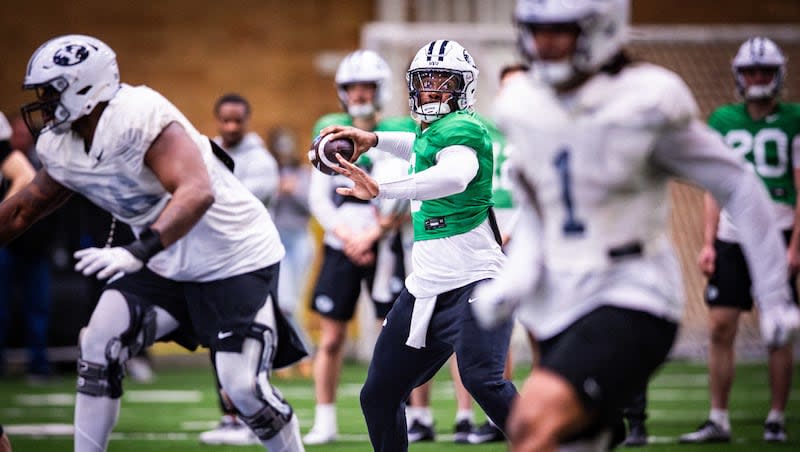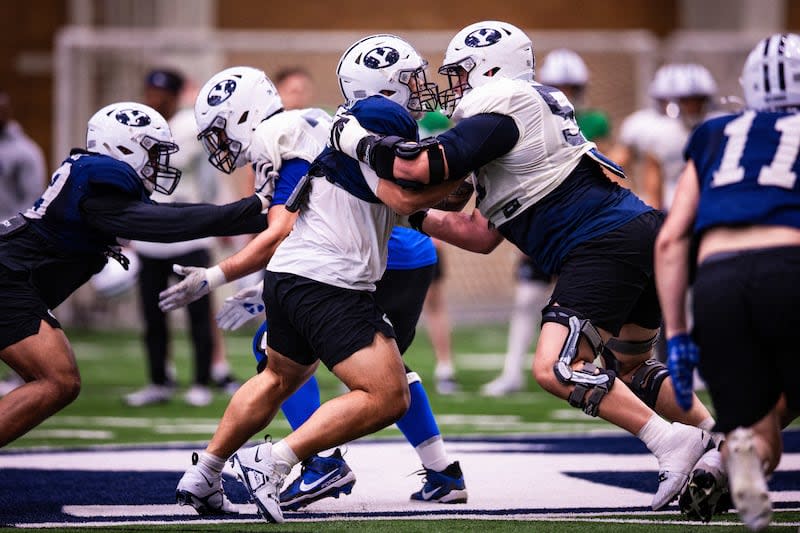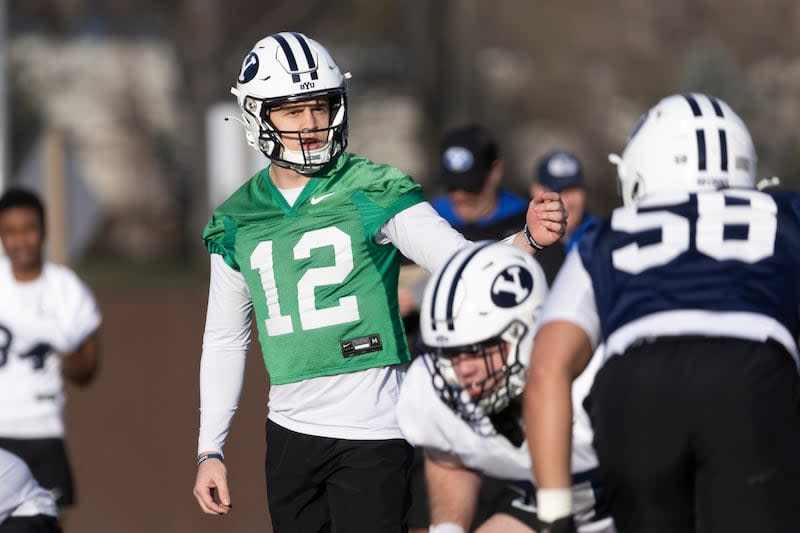What BYU’s offense accomplished, and what coaches learned, during 15 spring practices

Before spring football practices began on Feb. 29 for the BYU Cougars, offensive coordinator Aaron Roderick and head coach Kalani Sitake outlined the objectives for the offense in 2024, priorities in camp that would help the group avoid the sputtering that too often defined the unit in 2023.
“We are improving. I thought we got better this spring. We still have a long way to go. But definite improvement, especially in our run game,” Roderick said. “We worked really hard at that this spring and I think we are heading in the right direction.”
BYU OC Aaron Roderick
At the top of the list: re-establish the bruising rushing attack that was the bedrock of the offense in 2020, 2021 and 2022.
After the Cougars broke camp Saturday with their 15th and final practice, Roderick and Sitake said significant progress was made in that regard, but there’s clearly more work to be done when preseason training camp begins in early August.
“I like the improvement I have seen from those guys,” Sitake said, referring to the offensive linemen, running backs, tight ends and receivers.
Of course, many of the offensive players who will be key ingredients in BYU’s second season in the Big 12 didn’t do much in spring camp, because of injury or the desire from coaches to keep them healthy in what was a fairly physical bunch of practices in March. Offensive lineman Brayden Keim, running back LJ Martin, tight end Ethan Erickson and receivers Kody Epps, Darius Lassiter and Keelan Marion didn’t do much, if anything at all.
“Fifteen practices down, and (we) feel really good about where we are at,” Sitake said. “In terms of the team health, everybody should be ready to go by the time we hit fall camp. I think the only (hold-out) will be one player, and that is (offensive lineman) Justice Ena. … Everybody else should be good.”
Martin, the freshman who emerged as RB1 last year when Aidan Robbins sustained a rib injury, will obviously be a key part of that movement to move the ball more on the ground. The rising sophomore got some work early in camp, then saw his reps taper off because the coaches know what he can do and wanted to get more looks at Miles Davis, Hinckley Ropati and freshman Pokaiaua Haunga.
“We are improving. I thought we got better this spring. We still have a long way to go. But definite improvement, especially in our run game,” Roderick said. “We worked really hard at that this spring and I think we are heading in the right direction.”
When the great Tyler Allgeier moved on after the 2021 season, BYU brought in Chris Brooks from the transfer portal. Last year, Roderick replaced Brooks with Robbins. Barring a post-spring chance to add a “difference-maker,” the Cougars will ride with the aforementioned. Redshirt-junior Enoch Nawahine and freshmen Jovesa Damuni and Sione I. Moa are also in the mix, although Nawahine sustained an upper extremity injury and was in a sling the latter part of camp.
“That’s why we do spring ball so early, is so that if we do have injuries and they require surgery, we can get them back and have them ready to roll by the time we get to fall camp, and then that month of fall camp getting to the season they should be OK,” Sitake said.
As last year showed, BYU can never have enough capable running backs. Many a season have been derailed by injuries to that group. But the Cougars remain bullish on what they have.
“I like our running backs. We are not actively looking for any running backs, or receivers or anybody like that. You never say never. You never turn away a great player, if somebody wants to be here, I think at any position,” Roderick said. “But our need right now is one or two (offensive) linemen.”
Coaches have pointed to a couple of the padded scrimmages held on Saturdays during spring camp when the offense ran the ball effectively against a defense that is also holding out some key guys.
“The run game is an 11-man deal every play. We have improved at O line, and our tight ends are playing really well,” Roderick said. “It is also quarterbacks getting us into the right play, because a lot of our run plays are checks. So there is a lot to it, but I think we have improved in all areas.”
Offensive line coming along
We will roll out our projected depth chart for the BYU offense next week, but for now suffice it to say that the group has seemingly improved under the tutelage of new OL coach TJ Woods. At least that’s what almost everybody was saying after spring camp concluded.
Obviously, improvement was, and is, needed. Super senior Connor Pay, penciled in as the starting center again this year, concurred, saying that the unit fell short of expectations in 2023. Pay said that was one of the reasons why he returned, to make amends for himself and the group as a whole.
There’s some continuity — Pay, Caleb Etienne, Weylin Lapuaho and the Keim (sitting out with a thumb injury) are back — but more depth, and Big 12-type talent, is needed.
“I think we are all trying to learn coach Woods’ system. So I don’t know if continuity is playing a massive role,” Pay said. “But the nice thing about coach Woods’ system is that it is intuitive and there is not a lot of gray area. You know how to handle almost every situation. It is just a matter of doing the right things. I think continuity in the system has been huge for us and that builds a natural continuity with the guys at the line of scrimmage.”

Roderick said Woods and new tight ends coach Kevin Gilbride “are both outstanding coaches and we are really glad they are here.” He said they are already making a difference.
“Last year we lost so many of those offensive linemen (from the year before), it was a whole new group,” Roderick said, expressing a “reluctance” to pump up the group because there will be at least one new face in the starting five. “I think we are on the right track. Our defense has improved and we are doing a lot of good things against those guys. I think we are heading in the right direction, but we know how tough our schedule is. So we are going to stay humble and keep working.”
Wanted: More physical tight ends and receivers
More than once this spring, Sitake and Roderick have mentioned that all 11 guys on the field were to blame for the run-game woes in 2023, and not just the offensive linemen. That includes the tight ends and receivers.
The decision to move receiver Keanu Hill to tight end proved to be the right one in spring camp, Roderick said. The 6-foot-3, 240-pound Texas agreed, saying it best positions him for a shot at the NFL.
“Absolutely. He is a tight end. He is doing a really good job. It has been great because he doesn’t have to battle his weight to stay light enough to play receiver. He is 240, 245, easy. He is a mismatch as a route runner at tight end, and he’s a good blocker,” Roderick said.
Look for the Cougars to use more double tight end formations in 2024, with guys such as Hill, freshman Ryner Swanson, Erickson, Ray Paulo and Mata’ava Ta’ase charged with improving their blocking.
“They are working towards becoming great players,” Gilbride said. “And that’s all you can ask of them right now. Can I predict the future? No. But I am going to work into developing them into great all-around players and they are working at it right now.”
Receivers coach Fesi Sitake said the guys in his group know they have to become better downfield blockers for the run game to succeed.
“We had a string of eight, nine practices in a row where progressively we just got better, every single week. And then we kinda hit a little lull and had a few practices where you are not on the trajectory you were on,” Fesi Sitake said. “But you regroup and you bounce back, and the guys have shown maturity and we have gotten a lot better, I feel, over the course of spring. … Overall, there has been a lot of good plays made and I think we are on the right track.”
Starting quarterback is the big question
What Kalani Sitake and his offensive coaches didn’t learn through 15 practices is which starting quarterback candidate — Jake Retzlaff or Gerry Bohanon — is ready to step in and be QB1 on opening day.
Roderick said Saturday that the competition will continue in fall camp.
From this perspective, it appears that Retzlaff is in the lead, if only because he knows the offense better, having started the final four games in 2023. That said, Bohanon played better in the media-viewing portion of the 15th practice. So who knows?
“They are actually more similar than they are different. Yeah, they are both athletic. They both can make the throws that we need them to make in this offense, and they are both really smart,” Roderick said. “Gerry has a little more experience overall. Jake has the advantage of knowing our offense a little better than Gerry does. So it has been a really good battle.”
Kalani Sitake said the “bottom line” is that he is confident that the pieces are in place for the offense to improve, the running game to develop, and the right quarterback to be found to make BYU’s offense one of the better ones in the Big 12.
“As far as checking the boxes, if the culture is thriving and moving, I think we will be fine. The program is not going to be about one player, one coach. So we just keep rolling together,” Sitake said. “I feel good about practice one to where we finished (Saturday). I feel really good about where we are at.”


